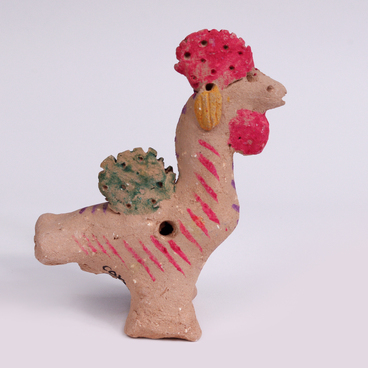The figurine ‘Rooster’ is a Dymkovo clay toy. Such fabulous roosters with bright painted tails are made quite often. The birds are decorated with a lot of elements and colored patterns.
It is believed that the Dymkovo craft originated in the Dymkovo settlement in the 15th — 16th centuries. It was founded under Ivan III: by Royal decree, some of the inhabitants of Veliky Ustyug moved to the newly annexed Vyatka lands. People settled on the right bank of the Vyatka River opposite the town of Khlynov. Later, the city was renamed Vyatka, and in Soviet times it turned into Kirov.
The development of the Dymkovo clay toy was related to the ritual spring holiday of Svistoplyaska (i.e. whistle-dance), later known as Svistunya. On that day, people spent the morning commemorating the deceased, and then boisterous festivities were held. People made noise, danced, and blew various whistles made of wood, tin and clay. In the 19th century, the morning commemoration became shorter, but the celebrations became longer, passing to the next day, sometimes lasting even three days.
Blowing a whistle was the holiday’s main feature and entertainment. The clay whistles for Svistoplyaska were made by the Dymkovo women. Small ducks, sheep, horses, and goats were painted with various bright colors. When the holiday was over, the colored toys were placed between window frames. Such toys were kept in almost every window in Vyatka and the settlement.
Interestingly enough, the old Dymkovo toys were completely different from the modern ones. The modeling was thin-walled, and the detailing was fine. The images resembled simplified copies of porcelain and earthenware figurines: young ladies in hoop skirts simpered holding hands, ladies dressed in the same outfits and capes carried umbrellas. The coloring was quite restrained: only two or three muted colors, usually yellow, black and bice.
The recognizable style of the Dymkovo toy was formed in the mid-19th century. Its distinctive features are an abundance of decor, a bright white background, and an elegant painting technique. It is worthy of note that the Dymkovo workpieces always turn red brown after firing. Therefore, the figures are whitened. For a long time, a solution of milk and chalk was used for whitewashing: the master completely dipped the figure into it, then the milk on the surface turned sour and the product was covered with a bright glaze of casein glue.
The patterns that are applied over the whitewash are closely related to the symbols of nature. Solar and lunar signs symbolized the origin of life, diamonds mean fertility, waves are used as a sign of the sky and water. There is a solar sign visible on the chest of the museum rooster.
It is believed that the Dymkovo craft originated in the Dymkovo settlement in the 15th — 16th centuries. It was founded under Ivan III: by Royal decree, some of the inhabitants of Veliky Ustyug moved to the newly annexed Vyatka lands. People settled on the right bank of the Vyatka River opposite the town of Khlynov. Later, the city was renamed Vyatka, and in Soviet times it turned into Kirov.
The development of the Dymkovo clay toy was related to the ritual spring holiday of Svistoplyaska (i.e. whistle-dance), later known as Svistunya. On that day, people spent the morning commemorating the deceased, and then boisterous festivities were held. People made noise, danced, and blew various whistles made of wood, tin and clay. In the 19th century, the morning commemoration became shorter, but the celebrations became longer, passing to the next day, sometimes lasting even three days.
Blowing a whistle was the holiday’s main feature and entertainment. The clay whistles for Svistoplyaska were made by the Dymkovo women. Small ducks, sheep, horses, and goats were painted with various bright colors. When the holiday was over, the colored toys were placed between window frames. Such toys were kept in almost every window in Vyatka and the settlement.
Interestingly enough, the old Dymkovo toys were completely different from the modern ones. The modeling was thin-walled, and the detailing was fine. The images resembled simplified copies of porcelain and earthenware figurines: young ladies in hoop skirts simpered holding hands, ladies dressed in the same outfits and capes carried umbrellas. The coloring was quite restrained: only two or three muted colors, usually yellow, black and bice.
The recognizable style of the Dymkovo toy was formed in the mid-19th century. Its distinctive features are an abundance of decor, a bright white background, and an elegant painting technique. It is worthy of note that the Dymkovo workpieces always turn red brown after firing. Therefore, the figures are whitened. For a long time, a solution of milk and chalk was used for whitewashing: the master completely dipped the figure into it, then the milk on the surface turned sour and the product was covered with a bright glaze of casein glue.
The patterns that are applied over the whitewash are closely related to the symbols of nature. Solar and lunar signs symbolized the origin of life, diamonds mean fertility, waves are used as a sign of the sky and water. There is a solar sign visible on the chest of the museum rooster.


